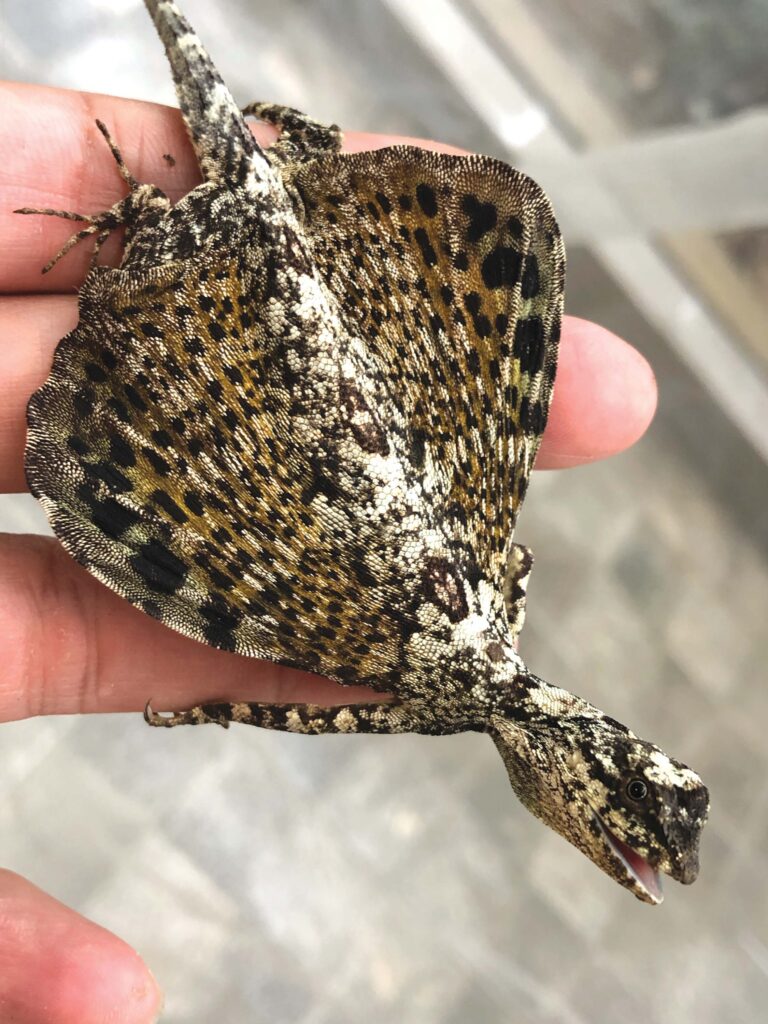Now that we are done with the Tuko, it is time to move up, literally. Allow me to introduce the hidden dragon of our forests, Draco. Now, this is another amazingly out-of-this-world creature whom I missed so much.
I saw them once in a while at school, during my elementary years. They are very shy animals and would keep a good distance away from humans. That was probably why most of the younger generation here in Puerto Princesa City do not know they exist. Heck, even my classmates did not know we
had them in our school garden.

Out of all the wonderful creatures I have encountered, Flying Lizards were a favorite, because they were truly beautiful and quite uncommon (they stayed well- hidden), and they seemed to come from another world.
It is unfortunate that they are really hard to find these days. Habitat destruction, killing due to ignorance, and capture for the pet trade really took a toll on their numbers.
I am so glad that I met this nice specimen in my brother’s backyard during my stay there. They were out of this world because, like the Flying Lemur and Flying Snake, they were able to do something that their entire taxonomic family could not: fly.

LUCKY RESCUE
It was on an afternoon of an ordinary sunny day. I heard a commotion among the helpers, who were running to and fro excitedly in the outdoor laundry area. They had saved a “strange” Lizard from being devoured by the Chickens.
The Flying Lizard made a grave error of venturing into the backyard Chicken farm, a 10×20 meter fenced area. Lucky for the Lizard, the helpers happened to be feeding the Chickens. As she was spotted by the flock, they started chasing her and stamping on her, trying to make a meal out of her.
The helpers put the Lizard inside the fodder pail to save her from the hungry Chickens. As they came into the laundry area and as the dazed Lizard recovered from the attack, she suddenly opened her mouth and, according to the helpers, the rest of her body. This was what caused the commotion: The helpers were freaked out by the threatening display.
I ran downstairs as fast as I could and told the helpers to put their brooms, dust pans, and other improvised weaponry down. I was hoping with all my heart that the rescued animal was a Flying Lizard, and indeed, she was!

DEFENSIVE STANCE
I was very elated as I caught a glimpse of the creature inside the pail and delighted that she was not injured by the stampede. This specimen had a head and a body bigger than the Butiki, which would make her a regular-sized adult. The tail was long and slender, and I bet it was used as a flight stabilizer.
I told the helpers what the creature was and that the open mouth was just an empty threat. Her teeth were so small that one would need a magnifying glass to see them. Unlike with the adult Tuko, I did not mind getting bitten by a Flying Lizard, and they never did bite me, maybe because they did not want us to know just how harmless they were.
Meanwhile, the opened wings were just meant to make her look bigger and more menacing. Many of her predators, one of whom will be discussed later, swallow their prey whole. By opening up her wings, she would have more than doubled her girth. She would have looked pretty hard to swallow.
As I took her out of the pail, she probably realized that the pretense of fierceness already fell through, so she meekly allowed me to lift her out.
Satisfied with the number of pictures I was able to snap, I took the Flying Lizard out to the garden. My daughter was skeptical with the flight thing, so I threw the Lizard about two meters up. Lo and behold, she glided so gracefully to the bushes about 10 meters away from us.
It was truly a sight to behold.
I had to explain to my daughter that the Flying Lizard did not really fly. She just glided as she leapt off from tree to tree. Similar to the Flying Squirrel and Flying Lemurs, she had this membrane or skin called a patagium that allowed her to glide through air.
In the case of the Flying Lizard, this membrane is attached to rib extensions.
RESIDENT GLIDERS
I was resigned with the thought that Flying Lizards had become too rare to come across. But after I came to see such a wonderful specimen, I began to be more observant of the canopy line in the area. It was a good thing that my bedroom in my brother’s house was on the second floor, which meant I had a very good view of the trees and branches.
Not long after releasing “Lizzie” back to
the woods, I saw a juvenile gliding from the towering acacia to the nearby langka tree. I was doubtful at first, since there were so many falling leaves and that might have been a leaf being blown sideways. But as I looked closely, the “leaf” attached themself to the langka branch and started crawling up.
No doubt about it, it was a juvenile Flying Lizard. From time to time, I would also see a pair of adult Flying Lizards patrolling up and down the acacia tree. That was. probably their territory, which would explain why that juvenile had to glide out of their way.

Photography by VINCENT LAO and ALVIN LAO


![Palawan encounters: The Resurgence (THREE OF A THREE-PART SERIES) [1/3]](https://files.animalscene.ph/wp-content/uploads/2023/01/shutterstock_1979742788-orange.png)



